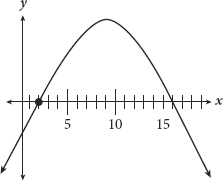PSAT Math Multiple-Choice Question 439: Answer and Explanation
Question: 439

Which of the following equations could represent the above graph?
- A. y = -x2 + 18x - 32
- B. y = -x2 + 14x - 32
- C. y = x2 - 14x - 32
- D. y = x2 + 18x + 32
Correct Answer: A
Explanation:
A
Difficulty: Hard
Category: Graphs of Quadratics
Strategic Advice: Use the visual information in the graph to eliminate answers quickly. A negative coefficient of the squared term means that the graph opens downward. The roots of a quadratic are where the graph crosses the x-axis.
Getting to the Answer: Because the quadratic opens downward, the x2-coefficient must be negative, so you can eliminate (C) and (D). According to the graph, the roots are x = 2 and x = 16. That means that the factored form of the quadratic will be either (-x + 2)(x - 16) or (x - 2)(-x + 16). These factored forms are actually equivalent because (-x + 2) = (-1)(x - 2) and (x - 16) = (-1)(-x + 16), which means:
(-x + 2)(x - 16) = (-1 × -1)(x - 2)(-x + 16)
(-x + 2)(x - 16) = (x - 2)(-x + 16)
Use FOIL on one of them to see if it matches the expanded form of the quadratic in (A) or (B):
(-x + 2)(x - 16) = -x2 + 16x + 2x - 32
= -x2 + 18x - 32
Thus, (A) is correct.
Another approach would be to use Picking Numbers. After eliminating (C) and (D) for having upward parabolas and calculating the roots, simply pick the more manageable of the two x-intercepts, x = 2, and plug it into the equations in (A) and (B) to see which one results in y = 0:
(A): y = -(2)2 + 18(2) - 32
y = -(4) + 36 - 32 = 0, keep.
(B): y = -(2)2 + 14(2) - 32
y = -(4) + 28 - 32 = -8 ≠ 0, eliminate.
(A) is indeed correct.
Test Information
- Use your browser's back button to return to your test results.
- Do more Math Multiple-Choice Tests tests.
More Tests
- PSAT Math Multiple-Choice Test 1
- PSAT Math Multiple-Choice Test 2
- PSAT Math Multiple-Choice Test 3
- PSAT Math Multiple-Choice Test 4
- PSAT Math Multiple-Choice Test 5
- PSAT Math Multiple-Choice Test 6
- PSAT Math Multiple-Choice Test 7
- PSAT Math Multiple-Choice Test 8
- PSAT Math Multiple-Choice Test 9
- PSAT Math Multiple-Choice Test 10
- PSAT Math Multiple-Choice Test 11
- PSAT Math Multiple-Choice Test 12
- PSAT Math Multiple-Choice Test 13
- PSAT Math Multiple-Choice Test 14
- PSAT Math Multiple-Choice Test 15
- PSAT Math Multiple-Choice Test 16
- PSAT Math Multiple-Choice Test 17
- PSAT Math Multiple-Choice Test 18
- PSAT Math Multiple-Choice Test 19
- PSAT Math Multiple-Choice Test 20
- PSAT Math Multiple-Choice Test 21
- PSAT Math Multiple-Choice Test 22
- PSAT Math Multiple-Choice Test 23
- PSAT Math Multiple-Choice Test 24
- PSAT Math Multiple-Choice Test 25